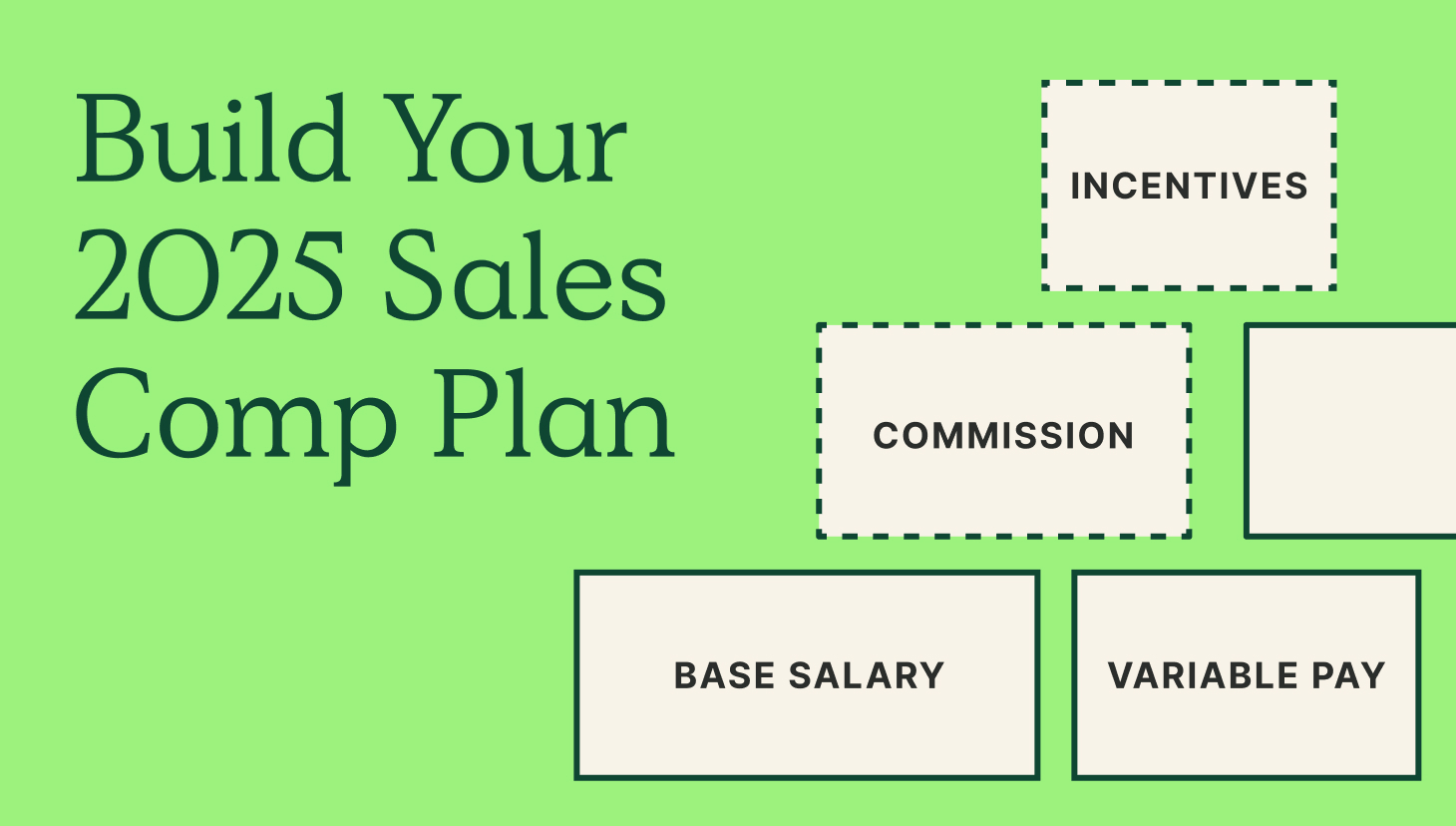This blog on paid parental leave explores how to adjust sales compensation plans and keep pipelines warm to better accommodate new parents in sales.
The lowest salaries at a company usually involve the sales teams’ base pay, with their variable pay balancing out the difference (and beyond).
It’s that variable pay that reps often accept positions over. In fact, many companies offer sales on-target earnings (OTEs) that far outrank their neighboring department peers’ salaries.
That’s all great, and to be expected, until we explore the murky waters of parental leave policies for individual contributing sales reps.
Most leave policies that we see only offer base salary pay for new parents who take leave.
“Every other employee at the company is getting their full normal pay while on leave, and their manager and the business accept that output for that team will decrease,” wrote Co-Founder and CEO at Parentaly Allison Whalen in her blog.
“And yet, most companies still will only guarantee their sales reps just their base pay during this time, and often, the business will expect the sales team to hit numbers as though the sales rep isn’t on parental leave.”
Seems unfair, no?
Try QuotaPath for free
Try the most collaborative solution to manage, track and payout variable compensation. Calculate commissions and pay your team accurately, and on time.
Start TrialThe gender gap widens
Not only would most people consider this unfair, but base-pay leave plans tend to hit women reps the hardest.
Expecting dads, for example, historically have taken on the secondary caretaker role. As a result, leave policies that pay only the base salary haven’t caused much of an issue.
At least that’s what the new mom of two Olivia Millard has observed throughout her 10-plus years working in SaaS sales.
“In my experience, men who have had children while working in sales typically take the minimum amount of leave,” said Olivia. “They have a child, keep their pipeline, come back early, and end up not sacrificing any deals.”
Women, however, more often assume the primary caretaker role and take full leave, as a result.
This leaves moms in sales with less leave pay than their colleagues from other functions and puts them in tough spots upon their return.
Empty pipelines
For instance, in addition to earning lower leave pay, new parents — moms especially — who take the full leave, often return to empty pipelines.
“At most companies, when a sales rep returns from parental leave they have a normal quota instead of a ramp quota. So they return to work with limited to no pipeline, yet are paid and evaluated against a fully productive AE quota,” wrote Allison.
This happened to Olivia when she returned to work after leave with her first child a few years ago.
“I came back to a full quota and hardly any opportunities in my pipeline,” Olivia said. “I felt like a failure starting from ground zero.”
As a salesperson, that’s the last feeling you want to have, especially when trying to navigate the added stress and pressure that comes with having a child.
“All you want to do is win in sales. You don’t want to be at the bottom of the leaderboard just because you were out on leave,” said Olivia.
Perhaps this is why so many women leave sales in pursuit of other roles, such as account management or customer success.
But for Olivia, who chose a career in tech sales, she didn’t want to bump to another function.
“The world is changing. Women coming up in sales are now in their 30s. They’re in their prime. They’re experts,” Olivia said. “They want fat paychecks and a family, too. How can companies make it sustainable for us to have a career in sales and a family?”
So, Olivia and other motivated people at her company did something about it.
Create Compensation Plans with confidence
RevOps, sales leaders, and finance teams use our free tool to ensure reps’ on-target earnings and quotas line up with industry standards. Customize plans with accelerators, bonuses, and more, by adjusting 9 variables.
Build a Comp PlanThe solution
They began by advocating for change in bite-size increments, setting out clear near-, mid-, and long-term goals. This allowed them to prioritize where to compromise and what leaders to loop in. It also helped them stay calm, Olivia said.
“We had to remove ourselves emotionally and do a lot of benchmarking with other companies who resembled our organization.”
“Then it’s just a sale,” Olivia said.
The results of their presentations, advocacy, and research led to changes that the company solidified.
Those changes included:
-
- Reps on parental leave would earn 60% of their OTE while out
-
- Upon return, reps may work 4-day weeks
-
- Distributing pipeline opportunities based on the sales cycle stage and splitting a percentage between the rep who takes it on and the rep who is on leave (ie: the further along the deal, the larger the percentage to the rep on leave)
-
- Ramping quota upon return from leave (based on sales segment)
-
- Codifying the new plan to avoid misinterpretation and grey areas
To learn how Olivia advocated for and made impactful changes at her organization around paid leave and sales compensation, we asked her a few questions.
What advice would you give others looking to change sales paid parental leave policies?
Olivia: Do not do this alone if you don’t have to, and treat it like a professional process like you would a sale. The more we professionalized it, the more progress we made. Start by finding your champion within your organization. Identify the motivations of those who are at the top and how much it will cost.
For us, that person was from human resources with the title Employee Advocate. She did her homework, brought it to our VP of Compensation’s attention, invited other leaders to be a part of it, and worked across divisions to get buy-in.
How did you go about benchmarking?
We approached benchmarking by taking a ‘who we want to be in the future vs. who we are as a company right now’ perspective. Who do we want to attract to work here? Do we want to compete with the larger tech companies for talent? As such, we looked into the policies at Facebook, LinkedIn, and Google, by connecting with people within our own network or finding them online if available.
How should leaders at companies approach rep-level paid parental leave?
You don’t have to be perfect as a company, but you have to be willing to grow and evolve with employee needs. Be willing to listen. Be willing to change. That’s why I stayed. A company that is willing to grow with me is what I look for.
Start by holding open dialogues with people who have already gone on leave. Talk to managers. Identify short-term solutions and rank the least expensive to most expensive solutions. Be willing to compromise on both sides.
Paid leave sales compensation plans
In addition to Olivia, we reached out to our Sr. Director of RevOps Ryan Milligan for leave best practices compensation strategies. He suggested the following when designing sales compensation plan parental policies.
-
- Evaluate how the person is compensated today.
Review the drivers of their sales compensation and what percentage of their OTE is base salary versus variable pay. How much do sales reps make? And, how much of their straight commission plans do they have control over?
- Evaluate how the person is compensated today.
-
- Plan for what happens while they are on leave.
Have a clear plan in place for what happens to the reps’ deals and incoming leads while they’re out. Who will keep them warm, and how will ownership of the deal split when it closes?
- Plan for what happens while they are on leave.
-
- Determine how progressive or conservative your organization will go.
The most conservative play would entail paying your reps base while they’re gone. Reversely, the most progressive policies pay full OTE. Maybe meeting in the middle works best by offering 60% OTE each month the person is out, like Olivia’s company.
- Determine how progressive or conservative your organization will go.
-
- Prepare for their return.
Keep those pipelines warm. Don’t have your reps feeling like failures on their first day back because they’re at the bottom of the leaderboard. Close deals and continue to feed and move prospects through the funnel.Even better, deploy ramp-up plans so that they have a fair shot at achieving OTE by year’s end.
- Prepare for their return.
-
- Communicate your comp plan leave policies
Lastly, as we suggest with any comp plan, communicate your policies. Explain the “whys” behind the policy and show the math to everyone on the sales team.
- Communicate your comp plan leave policies
Want some more help? We just went through structuring our own comp plans to support parents on leave. Reach out to kelly@quotapath.com and we’ll put you in touch with someone from our team to share our experience and offer suggestions.
About QuotaPath
QuotaPath provides sales compensation and commission tracking sales enablement software for scaling GTM organizations. Pairing an easy-to-use user experience with a highly technical backend, QuotaPath is the only solution fit to get Sales, RevOps, and Finance on the same page.
To see how we fit into your tech stack, check out our integrations page. And, to learn more, book a time with a member of our team today.



